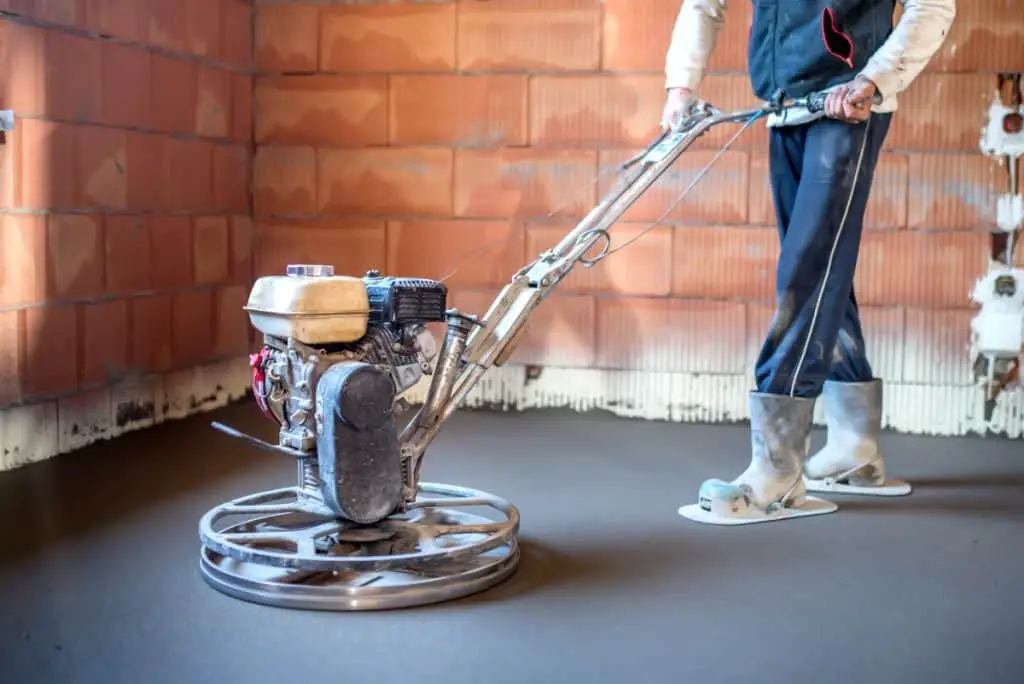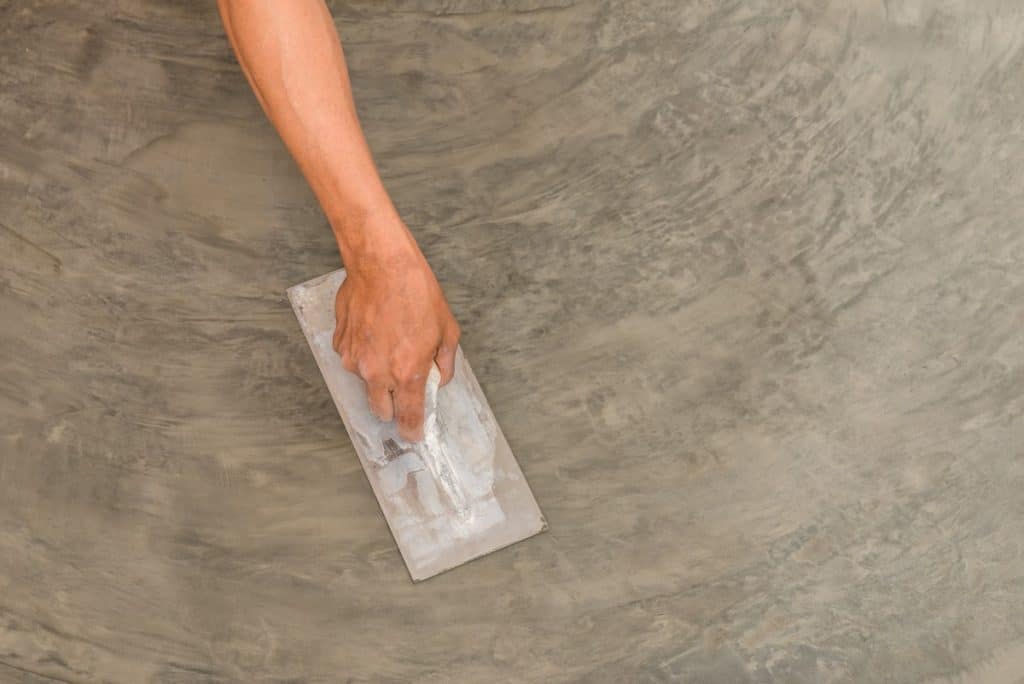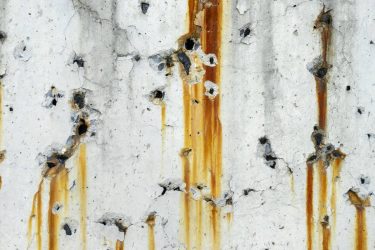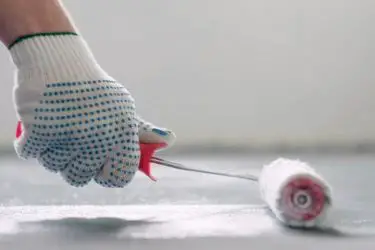Have you ever been to The Home Depot or Lowe’s Home Improvement and wondered how their concrete floors look smooth? Have you wondered what sort of concrete mix they’re using to get that glossy sheen? Here’s a hint, it doesn’t have to do with the concrete mixture itself.
While many people think that using a specific concrete mix will make the concrete smoother, the secret to making the cement the smoothest it can be is in how you finish the concrete. It requires polishing in the finishing stages of your concrete project to make your concrete as smooth as possible.
Here is a list of the 3 different types of finishes that can also leave your concrete flooring smooth.
- Polished Finish
- Power Troweled Finish
- Slick Troweled Finish

Table of Contents
Polished Finish
What is it?
A polished finish is a wax-less and coating-less finish you can apply to your cement flooring to make it smooth and attractive to look at. It is used by many concrete polishing contractors and is becoming a very popular method of finishing cement.
Concrete has been polished for over 4000 years. The original polished cement floor was found the ruins of the city of Jericho in Palestine and it has been used many, many times since.
Why use it?
There are many reasons why you would want to polish cement in any form. As previously stated, a high-gloss finish doesn’t require any waxing or coatings to protect it because it is already very durable. Waxing it would only dull the sheen. It’s also very easy and cheap to clean and maintain.
Proper polishing techniques will keep your floor even. There are many designs and decorations that give the polished concrete a more aesthetic appeal than anything. It gives a more “commercial” feel to space and resists high traffic.
Using a polishing finish increases the lifetime of the concrete by many decades, reduces allergens, and prevents mold growth. Many have claimed that the reflectiveness of the concrete can improve lighting and reduces the need to add more lighting to a given space.
It doesn’t matter what kind of concrete mix you use. Every type of concrete can be polished with few exceptions. If your concrete floor is new, there are no special mixes needed for the polishing finish. If your concrete floor is old, you should assess the condition of the concrete first before polishing. For example, cement slabs in poor condition may need to be resurfaced instead, especially if your concrete looks rocky.
How-To
When deciding how to best proceed with the product, consider whether you will be doing it yourself or employing a professional cement polishing contractor to do the job. You will need a floor polisher that is equipped with abrasive disks. Some polishers are more heavy-duty than others and have diamonds in the disk that grind down the cement.
Whatever you decide to do, make sure you know what you’re doing beforehand. The process of polishing cement requires that you remove flaws or defects from the cement and fill in any cracks with epoxy in order to give it that smooth, glossy sheen.
Keep the floor free of any kind of debris that could potentially wear or erode at the concrete.
Diamond-Polishing Process
First, add a concrete densifier to the concrete before polishing such as sodium, potassium, or lithium. Allow it to dry and cure. Monitor the hardness of the cement, and when it’s at the appropriate hardness, you’re ready to move on to the next step.
There are no specific instructions on how to grind the concrete floor. Begin by using a 30- to 40-grit metal-bonded diamond to grind the concrete down. Then move up to an 80-grit metal-bonded diamond. Finally, use a 150-grit or something finer. Do this until you’ve achieved the desired smoothness and reflectivity.
Reiterated here: Consider calling a professional polisher with experience in this arena if you are unsure of what to do.
Where to buy
Floor Polisher: Amazon
Densifier: The Home Depot
Abrasive Disks: Amazon
Power Troweled Finish

What is it?
A power trowel, also known as a power float, is another tool like the concrete polisher that you can use to apply a smooth finish to the concrete. There are two kinds of power trowels. The first is one in which you operate by walking behind. The second type is one in which you sit on top of the machinery and ride.
Why use it?
A power trowel uses stainless steel blades that spin to smooth out the surface of the cement and also to squeeze any residual water from the cement.
The power trowel smooths out the cement but does not create a smooth sheen as a cement polisher would.
How-To
Most power trowels are gas-powered. Make sure your machine has enough oil in it before starting. Follow the instructions included with your specific power trowel. Get a feel for how it steers, how to move it left or right. The best way to learn how to use a power trowel is to practice using one.
Where to buy
Power trowel: Amazon
Slick Troweled Finish

What is it?
To apply a slick trowel finish to your cement, you use either a hand trowel or a machine trowel. Whereas a polishing machine and a power trowel are used to smooth the surface of the concrete, this technique is mostly done by hand.
Why use it?
Hand trowels take longer to use and require more labor but are mostly used on small-scale projects. For example, you might not use a large polishing machine on small concrete steps leading to a back porch. It wouldn’t be wise to use this type of finish on a large, wide floor of a hardware store, for example.
This finish also has the added benefit of being easy to clean up afterward with a broom or mop.
How-To
Family Handyman offers good advice on how to pour a concrete slab and how to use a trowel to smooth out and finish the cement. The concrete needs to be hard enough to kneel or walk on but still soft enough to be able to work.
Where to buy
Cement Trowel: Amazon
All in all, the best way to bring out the smoothest sheen in your cement is not necessarily through the type of mixing of your cement but rather through how you finish the cement. The best smoothness comes through polishing the cement with a polishing machine by yourself or through a professional contractor.



